|
Undoubtedly, everyone has heard of the 10,000 rule that stipulates that in order to reach expert status 10 years or 10,000 hours of deliberate practice are required. This study was initially looking at elite musicians and their non-elite counterparts and was then transferred to other fields, including athletics. This has, in part, contributed to the growth of single sport athletes and the clubs, coaches, centers and equipment suppliers that support that sport. Unfortunately, early specialization does not guarantee long term athletic success, and may potentially limit it.
Whenever a new level of sport is undertaken, fewer athletes participate. The large number of youth athletes fizzles in high school, college and beyond. For those that do move on they tend to play more than one sport in high school with extra work put in to their main sport. They still require the deliberate practice required to excel, but not at the large commitment that has been suggested. There is also concern that early sport specialization can lead to injury, burnout and other negative consequences, although sufficient data is still required to fully understand the relationship. The information that we do have can help us to have honest conversations with athletes, coaches and parents when they ask us our opinion on playing one sport or multiple sports. One study looked at athletes that were in a single sport vs. multiple sports and the injuries in the two groups. Those athletes that played a single sport and spent more hours per week in that sport had greater risks for overuse injury. This total volume of repetitive activity is related to injury risk across many sports. Female athletes that play a single sport have increased incidence of anterior knee pain than those that play multiple sports. A lot of research has gone into youth baseball players and elbow injuries and we know that the risk factors for developing elbow pain are throwing too many pitches in a day, throwing curve balls at a young age and throwing more months out of the year. This understanding has helped lead to recommendations regarding pitch counts in youth baseball, although they may not be strictly adhered to. Gymnasts are more likely to have overuse wrist and lumbar injuries while specialized hockey and soccer players suffer from hip pain and the development of impingement. These injuries are predictable based on the sport. The understanding of when those injuries occur in relation to how often an athlete plays the sport is unknown. Theoretically, participating in many sports or a neuromuscular training program can limit the repetitive motion of an individual sport and improve movement quality that can lead to fewer injuries. The constant stress, physical and psychological, of intense sport training can lead some athletes to overtrain, or even burn out from their sport. In order to adapt physiologically, the body needs time to adjust to a new stimulus. Without adequate recovery periods built in, athletes may experience these, and other, negative outcomes of participation. Right now, the best we can do is to discuss the risk of injury based on the sport and the importance of adaptation and volume control. Sports are meant to be fun and youth athletes should be exposed to many sports for enjoyment. Waiting longer to specialize may help delay an overuse injury, but nothing is a guarantee for playing at the next level. The longer sports are fun the more likely they will be to remain active throughout their life, and that is the real victory. Conclusion:
References: Brenner, J. (2007). Overuse injuries, overtraining and burnout in child and adolescent athletes. Pediatrics 119(6). http://pediatrics.aappublications.org/content/119/6/1242.short Cheatham, S. and Little, B. (2015). Early sports specialization: helpful or harmful? Orthopedics 38(12). http://www.healio.com/orthopedics/journals/ortho/2015-12-38-12/%7B460ea434-603f-4c5b-9903-26940ea2349b%7D/early-sports-specialization-helpful-or-harmful Committee on Sports Medicine and Fitness. (2000). Intensive training and sport specialization in young athletes. Pediatrics 106(1). http://pediatrics.aappublications.org/content/106/1/154?trendmd-shared=0&utm_source=TrendMD&utm_medium=TrendMD&utm_campaign=Pediatrics_TrendMD_0 DiFiori, J, et. al. (2014). Overuse injuries and burnout in youth sport: A position statement from the American Medical Society for Sports Medicine. Clinical Journal of Sports Medicine 24(1): 3-20. https://www.amssm.org/Content/pdf%20files/2014_OverUse_Injuries-Burnout.pdf Fabricant, P., et. al. (2016). Youth sport specialization and musculoskeletal injury: A systematic review of the literature. The Physician and SportsMedicine 44(3); 257-262. https://www.ncbi.nlm.nih.gov/pubmed/27121730 Hall, R., et. al. (2015). Sport specialization’s association with an increased risk of developing anterior knee pain in adolescent female athletes. Journal of Sport Rehabilitation 24(1). https://www.ncbi.nlm.nih.gov/pubmed/24622506 Jayanthi, N., et. al. (2013). Sports specialization in young athletes: evidence based recommendations. SportsHealth 5(3). https://www.ncbi.nlm.nih.gov/pubmed/24427397 LaPrade, R., et. al. (2016). AOSSM early sport specialization consensus statement. Orthopedic Journal of Sports Medicine 4(4). https://www.ncbi.nlm.nih.gov/pubmed/27169132 McLeod, T., et. al. (2011). National Athletic Trainer’s Association position statement: prevention of pediatric overuse injuries. Journal of Athletic Training 46(2) http://www.nata.org/sites/default/files/Pediatric-Overuse-Injuries.pdf
1 Comment
12/14/2021 03:07:27 am
Looking for a best Divorce Lawyer in Chennai? We have a team of experienced divorce lawyers for your problem solving.
Reply
Leave a Reply. |
AuthorI write on sport management, fitness, sports medicine and business topics to help you reach your goals Archives
February 2024
Categories
All
|
|
Home
About Contact |
To learn more about what services we offer, to schedule an appointment or to get prices please contact me at
[email protected] (607)279-6791 *This site is for educational purposes only, it is not meant to diagnose, treat or replace medical advice. Before starting an exercise program always make sure that you are healthy and able to do so safely.* |


 RSS Feed
RSS Feed